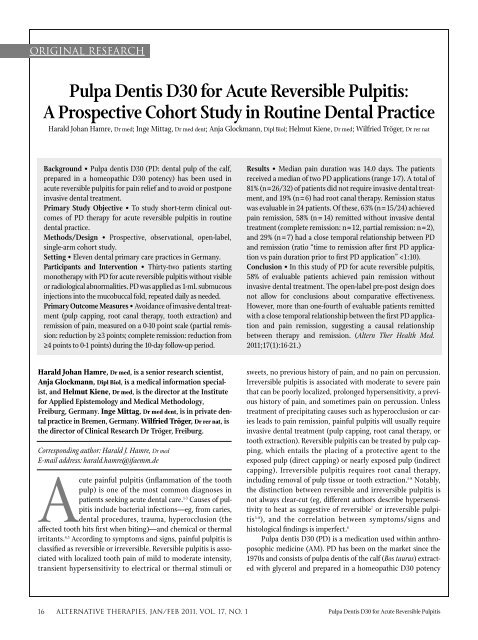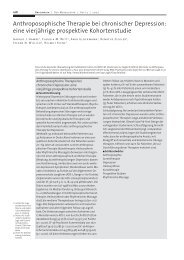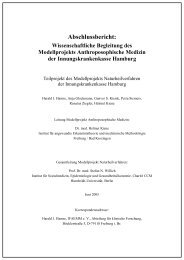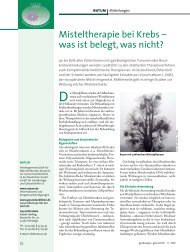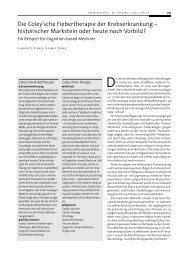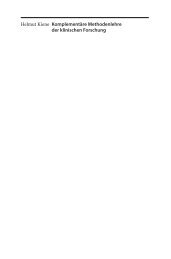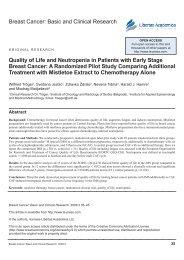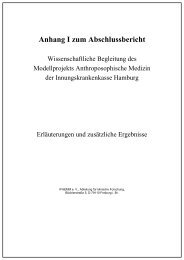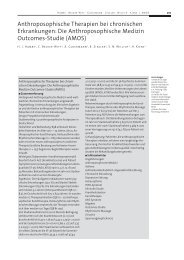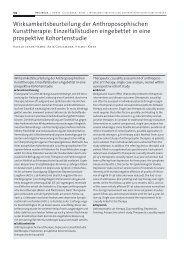Pulpa Dentis D30 for Acute Reversible Pulpitis
Pulpa Dentis D30 for Acute Reversible Pulpitis
Pulpa Dentis D30 for Acute Reversible Pulpitis
You also want an ePaper? Increase the reach of your titles
YUMPU automatically turns print PDFs into web optimized ePapers that Google loves.
original research<br />
<strong>Pulpa</strong> <strong>Dentis</strong> <strong>D30</strong> <strong>for</strong> <strong>Acute</strong> <strong>Reversible</strong> <strong>Pulpitis</strong>:<br />
A Prospective Cohort Study in Routine Dental Practice<br />
Harald Johan Hamre, Dr med; Inge Mittag, Dr med dent; Anja Glockmann, Dipl Biol; Helmut Kiene, Dr med; Wilfried Tröger, Dr rer nat<br />
Background • <strong>Pulpa</strong> dentis <strong>D30</strong> (PD: dental pulp of the calf,<br />
prepared in a homeopathic <strong>D30</strong> potency) has been used in<br />
acute reversible pulpitis <strong>for</strong> pain relief and to avoid or postpone<br />
invasive dental treatment.<br />
Primary Study Objective • To study short-term clinical outcomes<br />
of PD therapy <strong>for</strong> acute reversible pulpitis in routine<br />
dental practice.<br />
Methods/Design • Prospective, observational, open-label,<br />
single-arm cohort study.<br />
Setting • Eleven dental primary care practices in Germany.<br />
Participants and Intervention • Thirty-two patients starting<br />
monotherapy with PD <strong>for</strong> acute reversible pulpitis without visible<br />
or radiological abnormalities. PD was applied as 1-mL submucous<br />
injections into the mucobuccal fold, repeated daily as needed.<br />
Primary Outcome Measures • Avoidance of invasive dental treatment<br />
(pulp capping, root canal therapy, tooth extraction) and<br />
remission of pain, measured on a 0-10 point scale (partial remission:<br />
reduction by ≥3 points; complete remission: reduction from<br />
≥4 points to 0-1 points) during the 10-day follow-up period.<br />
Harald Johan Hamre, Dr med, is a senior research scientist,<br />
Anja Glockmann, Dipl Biol, is a medical in<strong>for</strong>mation specialist,<br />
and Helmut Kiene, Dr med, is the director at the Institute<br />
<strong>for</strong> Applied Epistemology and Medical Methodology,<br />
Freiburg, Germany. Inge Mittag, Dr med dent, is in private dental<br />
practice in Bremen, Germany. Wilfried Tröger, Dr rer nat, is<br />
the director of Clinical Research Dr Tröger, Freiburg.<br />
Corresponding author: Harald J. Hamre, Dr med<br />
E-mail address: harald.hamre@ifaemm.de<br />
<strong>Acute</strong> painful pulpitis (inflammation of the tooth<br />
pulp) is one of the most common diagnoses in<br />
patients seeking acute dental care. 1-3 Causes of pulpitis<br />
include bacterial infections—eg, from caries,<br />
dental procedures, trauma, hyperocclusion (the<br />
affected tooth hits first when biting)—and chemical or thermal<br />
irritants. 4,5 According to symptoms and signs, painful pulpitis is<br />
classified as reversible or irreversible. <strong>Reversible</strong> pulpitis is associated<br />
with localized tooth pain of mild to moderate intensity,<br />
transient hypersensitivity to electrical or thermal stimuli or<br />
Results • Median pain duration was 14.0 days. The patients<br />
received a median of two PD applications (range 1-7). A total of<br />
81% (n = 26/32) of patients did not require invasive dental treatment,<br />
and 19% (n = 6) had root canal therapy. Remission status<br />
was evaluable in 24 patients. Of these, 63% (n = 15/24) achieved<br />
pain remission, 58% (n = 14) remitted without invasive dental<br />
treatment (complete remission: n = 12, partial remission: n = 2),<br />
and 29% (n = 7) had a close temporal relationship between PD<br />
and remission (ratio “time to remission after first PD application<br />
vs pain duration prior to first PD application”
Table 1 Potentized Organ Preparations Used in Anthroposophic Medicine<br />
<strong>Pulpa</strong> <strong>Dentis</strong> <strong>D30</strong> is a potentized organ preparation used in anthroposophic<br />
medicine (AM). AM is a complementary system of medicine<br />
founded by Rudolf Steiner and Ita Wegman. 10 AM involves special artistic<br />
and physical therapies and special medications. AM medications are<br />
made of mineral, botanical, or zoological origin or are chemically<br />
defined substances. All AM medications are manufactured according to<br />
Good Manufacturing Practices and national drug regulations; quality<br />
standards of raw materials and manufacturing methods are described in<br />
the Anthroposophic Pharmaceutical Codex. 9<br />
AM medications can be prepared in concentrated <strong>for</strong>m or potentized. 9<br />
During potentization, a procedure also used in homeopathy, the original<br />
substance is successively diluted, each dilution step involving a<br />
rhythmic succussion (repeated shaking of liquids) or trituration (grinding<br />
of solids into lactose monohydrate). A <strong>D30</strong> potency (also called 30X)<br />
has been potentized in a 1:10 dilution <strong>for</strong> 30 times, resulting in a 1:10 -30<br />
dilution. Since potencies beyond D23 do not contain any molecules of<br />
the original substance, effects cannot readily be explained by molecular<br />
mechanisms. However, a systematic review of in vitro studies found biological<br />
effects of potencies ≥D23 in nearly three-fourths of the studies<br />
and in more than two-thirds of the studies with highest quality. 11<br />
Potentized organ extracts from higher animals (potentized organ<br />
preparations) were introduced in homeopathy and further developed<br />
in AM. 12 Potentized organ preparations are believed to regulate physiological<br />
processes in the respective organ from which they are prepared.<br />
13 In acute inflammations organ preparations are typically used<br />
in <strong>D30</strong> potencies. 14 All potentized organ preparations used in AM are<br />
prepared from animals bred on selected biodynamic farms where<br />
meat or bone meal has never been used in the diet 15 ; there is there<strong>for</strong>e<br />
no risk of prion transmission.<br />
(Table 1). 9 For reversible pulpitis, PD has been used <strong>for</strong> pain<br />
relief and to avoid or postpone invasive dental treatment. PD can<br />
be used alone or combined with other AM medications. 16,17 For<br />
acute pulpitis, 1 mL PD is injected submucously in the mucobuccal<br />
fold adjacent to the affected tooth or applied orally. 17 PD<br />
applications may be repeated daily as needed. Costs are approximately<br />
1.0 to 1.5 Euro <strong>for</strong> a 1 mL ampoule of PD. PD therapy <strong>for</strong><br />
pulpitis has been evaluated in case reports and retrospective surveys.<br />
18 We here present a prospective observational study of PD<br />
as monotherapy <strong>for</strong> acute reversible pulpitis without visible or<br />
radiological abnormalities.<br />
METhODS<br />
Design and Objective<br />
This was a prospective, observational, open-label, singlearm<br />
therapy study in a dental primary care setting. The objective<br />
was to describe short-term clinical outcomes in patients treated<br />
with PD as monotherapy <strong>for</strong> acute reversible pulpitis without visible<br />
or radiological abnormalities.<br />
Participating <strong>Dentis</strong>ts<br />
All dentists certified by the Physicians’ Association <strong>for</strong><br />
Anthroposophical Medicine in Germany as AM dentists and<br />
<strong>Pulpa</strong> <strong>Dentis</strong> <strong>D30</strong> <strong>for</strong> <strong>Acute</strong> <strong>Reversible</strong> <strong>Pulpitis</strong><br />
working in primary care (n = 34) were invited to participate in the<br />
study. In addition, 13 dentists were contacted at AM congresses.<br />
Of these 47 dentists, 14 dentists agreed to participate, and 11 dentists<br />
recruited patients into the study (certified AM dentists: n = 9,<br />
contacted at AM congresses: n = 2). The dentists were regularly<br />
using PD <strong>for</strong> acute reversible pulpitis in their practices.<br />
Eligibility Criteria<br />
Patients seen in routine dental practice with a clinical diagnosis<br />
of acute reversible pulpitis were considered <strong>for</strong> inclusion.<br />
Inclusion criteria were<br />
1) age ≥18 years;<br />
2) localized dental pain;<br />
3) sensitivity of the affected tooth to cold, heat, or percussion;<br />
4) pain duration of 2 days to 6 weeks; and<br />
5) starting treatment with PD as monotherapy.<br />
Exclusion criteria were abnormal findings on visual inspection<br />
or radiological examination of the affected tooth (such as<br />
caries), pain from dysgnathia, trigeminal neuralgia, periodontal<br />
pain, marked signs of inflammation of the periodontal tissues,<br />
planned invasive dental treatment <strong>for</strong> pulpitis (pulp capping,<br />
root canal therapy, tooth extraction), planned treatment with<br />
antibiotics, and planned change in ongoing analgesic medication<br />
<strong>for</strong> the dental pain. All treatment including PD was administered<br />
at the discretion of the dentists; the decision to start treatment<br />
with PD was not subject to <strong>for</strong>mal assessment.<br />
Clinical Outcomes<br />
Each patient was classified by the following predefined criteria.<br />
Invasive Dental Treatment Avoided. No pulp capping, root<br />
canal treatment, or tooth extraction during the 10-day follow-up<br />
period after first PD application.<br />
Pain Remission. No Remission. Reduction of pain intensity<br />
(documented on numeric rating scales from 0 “no pain” to 10<br />
“worst possible pain”) by
Average pain intensity was calculated <strong>for</strong> patients with at<br />
least two evaluable pain score values be<strong>for</strong>e and after first PD<br />
application, respectively.<br />
Data Collection<br />
All data were documented with questionnaires returned in<br />
sealed envelopes to the study office (dentist questionnaire:<br />
returned on Day 10; patient questionnaires: returned on Days 0,<br />
1, and 10). At study enrollment (Day 0) the dentists documented<br />
eligibility criteria, smoking, alcohol use, comorbid disorders, and<br />
adjunctive therapies <strong>for</strong> comorbid disorders; the patients documented<br />
pain in the past 14 days retrospectively, current pain, and<br />
the use of analgesics. During follow-up (Days 1-10), the dentists<br />
documented all treatment <strong>for</strong> pulpitis and adverse events and on<br />
Day 10, per<strong>for</strong>med vitality tests with cold stimuli; the patients<br />
documented pain intensity in pain diaries; the dentists and<br />
patients independently documented analgesic use and on Day 10,<br />
the perceived effectiveness of PD. Pain intensity was documented<br />
daily; on Days -1, 0, and 1 every 2 hours; and on Day 0 also immediately<br />
be<strong>for</strong>e the first PD application. Pain quality was documented<br />
on Day 0, using eight predefined descriptors.<br />
The patient follow-up responses were not available to the<br />
dentists. The dentists and patients received no financial or other<br />
compensation <strong>for</strong> study participation or use of PD.<br />
The data were entered twice by two different persons into<br />
Microsoft Access 97 (Microsoft Corp, Redmond, Washington).<br />
The two datasets were compared and discrepancies resolved by<br />
checking with the original data.<br />
Quality Assurance and Adherence to Regulations<br />
The study was registered with the National Association of<br />
Statutory Health Insurance Physicians and the Federal Institute<br />
<strong>for</strong> Drugs and Medical Devices and conducted according to the<br />
Declaration of Helsinki and the International Conference on<br />
Harmonisation Good Clinical Practice guidelines. Written<br />
in<strong>for</strong>med consent was obtained from all patients be<strong>for</strong>e enrollment.<br />
Because of the observational noninterventional nature of<br />
the study, approval by an ethics committee was not required.<br />
Data Analysis<br />
The data analysis (SPSS 14.0.1, SPSS Inc, Chicago, Illinois)<br />
was per<strong>for</strong>med on all patients fulfilling the eligibility criteria.<br />
Missing values <strong>for</strong> pain intensity during sleep or <strong>for</strong> other reasons<br />
were replaced with mean values of the individual patient in<br />
the respective period (Day -1, Day 0 be<strong>for</strong>e PD, Day 0 after PD,<br />
Day 1, from first day with pain to PD, from PD to last day with<br />
pain); missing data <strong>for</strong> other outcomes were not replaced. T-test<br />
was used <strong>for</strong> paired continuous data.<br />
RESulTS<br />
Patient Recruitment and Follow-up<br />
A total of 108 patients with a clinical diagnosis of acute reversible<br />
pulpitis were assessed <strong>for</strong> eligibility. Of these patients, 32 fulfilled<br />
all eligibility criteria and were included in the analysis; 76<br />
patients were not included. Reasons <strong>for</strong> exclusions were the following:<br />
planned other treatment <strong>for</strong> pulpitis (n = 69), no localized dental<br />
pain (n = 2), pain duration 6<br />
weeks (n = 2). The five patients with pain duration 6<br />
weeks fulfilled all other eligibility criteria and received PD, and<br />
their ineligibility was detected after completion of the study documentation;<br />
none of these patients had invasive dental treatment,<br />
and four patients were evaluable <strong>for</strong> remission: complete remission<br />
(n = 1), partial remission (n = 2), no remission (n = 1).<br />
The patients were enrolled from November 14, 2002, to<br />
August 15, 2003. The number of enrolled patients per dentist was<br />
one patient (n = 4 dentists), two to four patients (n = 5), and seven<br />
patients (n = 2). The dentist questionnaire (returned on Day 10)<br />
was available <strong>for</strong> all 32 patients; the patient questionnaires<br />
(returned on Days 0, 1, and 10) were available <strong>for</strong> 32, 28, and 25<br />
patients, respectively. Pain remission status was evaluable in 24<br />
patients, while eight patients had incomplete documentation of<br />
pain levels be<strong>for</strong>e (n = 3) or after (n = 7) first PD administration.<br />
Baseline Data<br />
Sociodemographics. Mean age was 42.6 ± 13.4 years (range<br />
19-79 years); 23 of 31 evaluable patients were women. The<br />
patients smoked regularly (n = 4/28 evaluable patients) or occasionally<br />
(n = 2), or did not smoke (n = 22). Alcohol was consumed<br />
regularly (n = 1/26), occasionally (n = 14), or never (n = 11).<br />
Dental Treatment Preceding <strong>Pulpitis</strong>. The dental pain had<br />
occurred after dental treatment in 22% (n = 7/32) of patients:<br />
preparation <strong>for</strong> crown (n = 1), placement of crown or bridge (n =<br />
3), placement of ceramic inlay (n = 3). The interval between dental<br />
treatment and the first PD application was 4 to 5 days (n = 4)<br />
and 12 to 25 days (n = 3).<br />
<strong>Pulpitis</strong> leading to Recent Dental Treatment. The dental<br />
pain had led to unsuccessful dental treatment in 6% (n = 2/32) of<br />
patients: direct capping (n = 1) and placement of composite filling<br />
(n = 1). The interval between dental treatment and the first<br />
PD application was 15 and 7 days, respectively.<br />
Dental Pain. The most frequently affected teeth were 14, 15,<br />
and 26 (each n = 3 patients) and 17, 24, 36, 37, and 46 (each n =<br />
2). Pain duration prior to the first PD application was 2 to 6 days<br />
(n = 8/29 evaluable patients), 7 to 13 days (n = 6), 14 to 27 days (n<br />
= 7), and 28 to 42 days (n = 8), with a median duration of 14.0<br />
days (interquartile range 5.5-31.5 days, mean 17.9 ± 13.5 days).<br />
Pain intensity immediately be<strong>for</strong>e the first PD application was 0<br />
to 3 points (n = 6/29 evaluable patients), 4 to 6 points (n = 17),<br />
and 7 to 9 points (n = 6). Most common pain descriptors, with<br />
multiple responses possible, were “dull” (n = 12/32 patients),<br />
“persistent” (n = 10), “abruptly occurring” (n = 8), “gnawing” (n =<br />
5), and “slowly swelling and subsiding” (n = 5).<br />
Comorbidity. A comorbid disorder was present in 28% (n =<br />
8/29) of evaluable patients. The most frequent comorbid disorders<br />
were hypertension (n = 3 patients) and psoriasis (n = 2).<br />
Treatment<br />
Treatment With PD and Analgesics. On Day 0, PD therapy<br />
18 ALTERNATIVE THERAPIES, jan/feb 2011, VOL. 17, NO. 1 <strong>Pulpa</strong> <strong>Dentis</strong> <strong>D30</strong> <strong>for</strong> <strong>Acute</strong> <strong>Reversible</strong> <strong>Pulpitis</strong>
was administered to all 32 patients. The total number of PD applications,<br />
including the first application, was one (n = 9 patients),<br />
two (n = 12), three to four (n = 10), and seven (n = 1), with a median<br />
of two applications per patient (interquartile range 1-3). All PD<br />
applications were submucous injections, except <strong>for</strong> three patients<br />
who had PD orally on Day 0; two of these subsequently had one<br />
submucous PD injection on Day 3, and the third had no PD injections<br />
and was also not evaluable <strong>for</strong> remission status. Analgesics<br />
were used by nine patients (paracetamol [acetaminophen], acetylsalicylic<br />
acid, or ibuprofen: n = 6, codeine-containing analgesic: n<br />
= 1, homeopathic analgesics: n = 2).<br />
Invasive Dental Treatment. A total of 19% (n = 6/32) of<br />
patients had root canal therapy, which was administered on Days<br />
0-1 (n = 2), Days 4-6 (n = 3), and Day 11 (n = 1). No patients had<br />
pulp capping or tooth extraction.<br />
Other Treatment <strong>for</strong> <strong>Pulpitis</strong>. A total of 16% (n = 5/32) of<br />
patients had other treatment <strong>for</strong> pulpitis. Two patients had dental<br />
treatment of the affected tooth (filling replaced on Day 1, polishing<br />
on Day 10), and three patients had other AM medications <strong>for</strong><br />
pulpitis (A-70 orally on Day 0, Periodontium/Silicea comp injected<br />
together with PD on Days 2 and 9, respectively).<br />
Clinical Outcomes<br />
Avoidance of Invasive Dental Treatment. A total of 81% (n<br />
Pain intensity<br />
Pain intensity<br />
10<br />
8<br />
6<br />
4<br />
2<br />
0<br />
10<br />
8<br />
6<br />
4<br />
2<br />
0<br />
Patient 1: Complete remission on Day 0<br />
with close temporal relationship<br />
-14-13-12-11-10 -9 -8 -7 -6 -5 -4 -3 -2 -1 0b0i0a 1 2 3 4 5 6 7 8 9 10<br />
Days<br />
Patient 3: No remission<br />
-14-13-12-11-10 -9 -8 -7 -6 -5 -4 -3 -2 -1 0b0i0a 1 2 3 4 5 6 7 8 9 10<br />
Days<br />
<strong>Pulpa</strong> <strong>Dentis</strong> <strong>D30</strong> <strong>for</strong> <strong>Acute</strong> <strong>Reversible</strong> <strong>Pulpitis</strong><br />
= 26/32) of patients did not require invasive dental treatment<br />
during follow-up. Vitality testing with cold stimuli was per<strong>for</strong>med<br />
on Day 10 on these patients (n = 23 evaluable patients);<br />
the tooth was found to be vital in all 23 cases.<br />
Pain Remission. A total of 63% (n = 15/24) of evaluable<br />
patients achieved pain remission, and 58% (n = 14/24) remitted<br />
without invasive dental treatment (complete remission n = 12,<br />
partial remission n = 2; examples in Figure 1). In the 14 patients<br />
with complete or partial remission without invasive dental treatment,<br />
time from first PD application to remission was 0 to 2<br />
hours (n = 6 patients), 1 day (n = 2), 2 to 4 days (n = 3), and 5 to 8<br />
days (n = 3); the ratio “time to remission after first PD application<br />
vs pain duration prior to first PD application” was
Table 2 Clinical Outcomes<br />
Item % n<br />
1. Invasive dental treatment (pulp capping, root canal<br />
therapy, tooth extraction) avoided 81% 26/32<br />
2. Partial or complete remission 63% 15/24<br />
3. 1 + 2 58% 14/24<br />
4. 1 + 2 + Close temporal relationship between<br />
<strong>Pulpa</strong> dentis application and remission (see<br />
Methods <strong>for</strong> details) 29% 7/24<br />
5. <strong>Pulpa</strong> dentis very effective or effective<br />
(patient rating on Day 10) 75% 18/24<br />
6. <strong>Pulpa</strong> dentis very effective or effective (dentist<br />
rating on Day 10) 79% 23/29<br />
points during Days -6 to -1, peaked at 5.15 ± 1.97 points immediately<br />
be<strong>for</strong>e first PD application (Figure 2, Day 0ib) and dropped<br />
to 3.10 ± 2.26 points on Day 0 after first PD application (Figure 2,<br />
Day 0a, average of score values documented every 2 hours), with<br />
a mean difference from Day 0ib to Day 0a of 2.05 points (95%<br />
confidence interval [CI] 1.15-2.95, P < .001). The corresponding<br />
difference in patients who did not require invasive dental treatment<br />
was 2.23 points (95% CI 0.51-1.16, P < .001, n = 21 evaluable<br />
patients, Figure 2). Pain intensity decreased further during Days<br />
3 to 10.<br />
Further outcomes are presented in Table 2. Adverse events<br />
did not occur during follow-up.<br />
DISCuSSIOn<br />
Main Findings<br />
This is the first prospective study of PD <strong>for</strong> pulpitis. We<br />
studied 32 consecutive patients with a clinical diagnosis of acute<br />
reversible pulpitis without visible or radiological abnormalities<br />
where PD was administered <strong>for</strong> pain relief and to avoid invasive<br />
dental treatment. The latter goal was reached in 81% of patients.<br />
More than half the evaluable patients had complete or partial<br />
pain remission without invasive dental treatment, more than<br />
one-fourth had a close temporal relationship between the first<br />
PD application and pain remission, and one-fourth remitted<br />
within 2 hours after the first PD application.<br />
Strengths and limitations<br />
Strengths of this study include a detailed assessment of<br />
treatment and pain outcome and a high representativeness. Onefourth<br />
of certified AM dentists working in primary care in<br />
Germany participated, and all eligible patients were enrolled.<br />
These features suggest that the study to a high degree mirrors the<br />
use of PD as monotherapy among AM dentists in primary care.<br />
It should be noted, however, that only one-third of the patients<br />
with acute reversible pulpitis seen by the participating dentists<br />
started PD as monotherapy (apart from analgesics) and were eligible<br />
<strong>for</strong> this study, whereas two-thirds required other treatment<br />
(eg, root canal therapy or other AM medications) and were not<br />
eligible. Compared to all patients treated <strong>for</strong> acute pulpitis in<br />
dental primary care, the study sample is there<strong>for</strong>e selected in two<br />
aspects: patients were seen by a subgroup of dentists offering<br />
AM therapy, and patients were deemed not to require immediate<br />
invasive dental treatment.<br />
A limitation of the study is the small sample size. Also, since<br />
the study was open-label, it cannot distinguish between biological<br />
effects of PD and other possible effects from receiving injections<br />
(nonspecific physiological effects of an injection, placebo<br />
effects, observation bias), but this issue may be less important in<br />
emergency dental care. Pain intensity in the days prior to study<br />
inclusion was documented retrospectively and may be affected<br />
by recall bias.<br />
Because the study did not have a control group, one has to<br />
consider other causes <strong>for</strong> the observed pain improvement apart<br />
from PD, such as adjunctive therapies. However, invasive dental<br />
treatment was required by only 19% of patients, and the remaining<br />
81% had a significant and sustained pain improvement. Other<br />
adjunctive therapies were administered to five patients, but in<br />
only one of these the adjunctive therapy was followed by a documented<br />
remission, after an interval of 6 days (Figure 1, Patient 4).<br />
Regression to the mean from study inclusion at symptom<br />
peaks is another factor to be considered. Average pain levels were<br />
stable in the last week be<strong>for</strong>e inclusion and increased by 0.85<br />
points on Day 0 be<strong>for</strong>e first PD application (Figure 2). This<br />
increase may be due to egression from the mean 21 but may also<br />
represent true clinical deterioration. Correspondingly, regression<br />
to the mean could explain a maximum of 0.85 points of the subsequent<br />
average improvement. 21<br />
Natural recovery is also to be considered: Pulp inflammation<br />
may be spontaneously reversible, probably related to a host<br />
of factors that mediate the inflammatory response. 4 There<strong>for</strong>e,<br />
spontaneous remission of pain, although unlikely to affect more<br />
20 ALTERNATIVE THERAPIES, jan/feb 2011, VOL. 17, NO. 1 <strong>Pulpa</strong> <strong>Dentis</strong> <strong>D30</strong> <strong>for</strong> <strong>Acute</strong> <strong>Reversible</strong> <strong>Pulpitis</strong><br />
Average pain intensity<br />
10<br />
8<br />
6<br />
4<br />
2<br />
0<br />
All evaluable patients<br />
Patients without invasive dental treatments<br />
-14-13-12-11-10 -9 -8 -7 -6 -5 -4 -3 -2 -1 0b0i0a 1 2 3 4 5 6 7 8 9 10<br />
Days<br />
FIGURe 2 Average Pain Intensity (0-10)<br />
Patients with at least two score values be<strong>for</strong>e and after first application of <strong>Pulpa</strong><br />
dentis (all evaluable patients: n = 26, patients without invasive dental treatment:<br />
n = 21). 0b and 0a indicate intensity on Day 0 be<strong>for</strong>e and after first the <strong>Pulpa</strong><br />
dentis application, respectively (average of score values documented every 2 h);<br />
0ib, intensity immediately be<strong>for</strong>e first the <strong>Pulpa</strong> dentis application.
than half of study patients within a 10-day observation period,<br />
cannot be totally excluded.<br />
Clinical outcomes also were assessed in individual patients,<br />
whereby more than half of evaluable patients had pain remission<br />
without invasive dental treatment <strong>for</strong> a condition where such<br />
treatment is usually considered mandatory, 6,7 and more than onefourth<br />
remitted with a close temporal relationship between PD<br />
administration and remission (time to remission from first PD<br />
application


